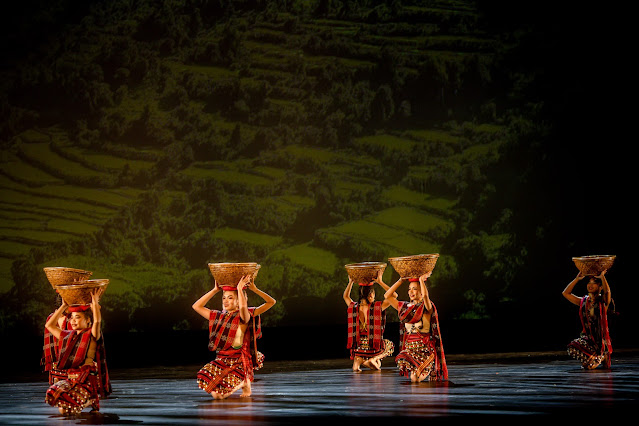Day Two of International Dance day performed at the Samsung Performing Arts theatre last April 24, 2025, featured the folk dance community. Not to be melodramatic but it nearly brought me to tears. I have rarely seen full productions dedicated entirely to folk dance, as lengthy shows are few and far between. Witnessing folk dance celebrated in such a magnificent way—and being reassured as a Filipino that the passion for our heritage and culture is still vibrant—was deeply touching. The show offered me a new perspective on folk dance. Wonderfully curated, it demonstrated that there is so much more to explore beyond the well-known dances we occasionally see.
The performances by various groups—Bayanihan, Kalilayan Folkloric Group of Catanauan Quezon, CEU Folk Dance Troupe, UE Silangan Dance Troupe, Sindaw Philippines Performing Arts Guild, UST Salinggawi Dance Troupe, RTU Kultura Rizal Dance Troupe, PNU Kislap Sining Dance Troupe, Kaloob Philippine Music and Dance Ministry, and Ramon Obusan Folkloric Group—painted a vivid picture of diversity and inclusivity. One group featured a voiceover that said, *"Bawat hakbang ay pag-ibig. Galing at galaw,"* which perfectly encapsulated what I witnessed. The performance showcased dancers of all ages, representing many communities that are not always in the limelight. It also included poetry, singing, chanting, and, of course, pulsating live music.
The groups brought their A-game in aesthetics, presenting glamorous costumes, intricate sets, and props that resembled treasures from exotic castles. These elements truly elevated the performances. The classics performed were revitalized and modified for new audiences.
Particularly memorable was UST Salinggawi Dance Troupe's "Kanayunan," which featured *Sayaw sa Bangko* (Dancing on Benches) and the famous *Tinikling*, among others. They took it to another level; for instance, in *Tinikling*, it is challenging enough to dance between the *kawayan* (bamboos) in perfect rhythm, but their version had numerous pairs dancing while the bamboos changed formation—moving clockwise as a group, then counterclockwise. It was thrilling to see them execute these tricks with confidence.
In *Sayaw sa Bangko*, they performed the usual tricks with full commitment to storytelling while incorporating acrobatics like straddle splits and cartwheels using the benches, which was highly entertaining. Through their very overt acting and creative nuances, UST celebrated the playfulness of the Filipino spirit.
A standout moment was the CEU Folk Dance Troupe's *Banga* dance, or water jar dance. Typically, the performers balance five to six jars of varying sizes on their heads—and they did just that. However, to my surprise, two dancers showcased their skills with ten to twelve jars, adding remarkable complexity to the performance. It was technically very difficult, yet done with the ease, poise, and elegance of the Filipino.
The UE Silangan Dance Group took a classic approach, and when their Maria Clara Suite dancers took the stage, the audience gasped. The costumes were beautiful and intricately designed, complementing the dancers' movements. The girls executed generous sweeps, while the boys showcased strong, polished stances, honoring Cora Inigo's original choreography as restaged by Gener Caringal. The classic became a standout in the sea of unconventional pieces.
Bayanihan performed a choreography by Ferdinand Jose with the echoes of the *Agung*. In a duet, the skill level of the dancers was on full display. The male lead performed a lunge and kneel combination, circling the woman. If that weren't impressive enough, soloist Ina Feleo also performed the same combination with grace and strength. The group also performed balancing acts using their musical instruments.
Throughout the show, there were so many balancing acts I had never seen before—balancing on gongs, plates, benches, stools. There were new depictions of Filipino life like the fishing community, playful theatrics, and warriors ready to fight.
The folk dance gala was like opening a book of untold stories about the Filipino. Truly, there is so much more to unravel and learn. Day Two was a powerful reminder that while folk dance may sit quietly in the back of some minds, it continues to evolve. Snippets of our culture remain encrusted in our folk dances—readily available for future generations.










